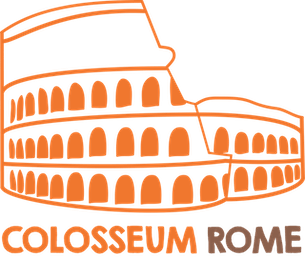
Curia Julia in Rome: How to Visit the Ancient Roman Senate House
Want to know what it was like inside an Ancient Roman senate building? This guide gives you everything you need to know about how to visit the Curia Julia in Rome, including where to find it, how to get there, and what to expect during your visit.
The Curia Julia in Rome is one of the best-preserved monuments in the Roman Forum. Built by Julius Caesar and finished under Augustus, this impressive structure was the official meeting place of the Roman Senate.
Learn more about its history, architecture, and role in political life. Start your journey and explore the fascinating world of the Ancient Roman senate building!
Contents
- 1 How to Visit the Curia Julia (Roman Forum Senate House)
- 2 Curia Julia Location & How to Get There
- 3 Curia Julia Opening Hours
- 4 The Roman Senate House – the Curia Julia Today
- 5 The Restoration of the Rome Curia
- 6 The importance of the Rome senate building
- 7 Details about the Curia of the Roman Forum
- 8 Short History of The Curia Julia Rome
- 9 Hotels near to the ancient Roman Senate building
- 10 Top Attractions near The Curia Julia in Rome
- 11 Frequently asked questions
- 12 Conclusion
How to Visit the Curia Julia (Roman Forum Senate House)
You can visit the Curia Julia, ancient Rome’s Senate House, as part of your ticket to the Roman Forum and the Colosseum. Most entry passes include access to all three iconic sites, letting you walk through the very heart of ancient Rome in one visit.
Here are your best options:
- Skip-the-line ticket : Book your Roman Forum and Colosseum entry online to save time at the gates (see here).
- Colosseum Guided tours : Join an expert-led Colosseum & Forum tour (check this one) to fully understand the history and political role of the Curia Julia.
- Rome Tourist Card : The all-in-one digital pass that covers the Colosseum, Roman Forum, Vatican Museums, and more, perfect if you’re planning to see several top attractions (check last price on this page).
👉 Check all the current ticket and tour options here to find the one that fits your travel plans best.
Curia Julia Location & How to Get There
The Curia Julia is one of the most important historical buildings in the Roman Forum, right in the heart of ancient Rome.
You’ll find the Curia Julia just a short walk from the Colosseum, Arch of Septimius Severus, and Temple of Saturn, making it easy to include in the same visit to the Forum and Palatine Hill. Its central location means you’ll likely pass right by it while exploring Rome’s most iconic archaeological sites.
How to get to the Curia Julia:
- By metro: Take Line B (blue line) and get off at Colosseo station. From there, enter the Roman Forum through the Via dei Fori Imperiali entrance — the Curia Julia is about a 10-minute walk inside the archaeological area.
- By bus: Buses 51, 75, 85, 87, and 118 all stop near Via dei Fori Imperiali or Piazza Venezia. From there, follow the signs to the Roman Forum entrance.
- On foot: If you’re visiting nearby landmarks like the Colosseum or Piazza Venezia, you can easily reach the Curia Julia in under 10 minutes.
You can check the exact location of the Curia Julia and get walking directions directly on Google Maps below.
Curia Julia Opening Hours

The Curia Julia, the ancient Senate House of Rome, is part of the Roman Forum and can currently be visited only on Saturdays and Sundays, according to the latest update from the Parco archeologico del Colosseo. This reduced schedule is due to ongoing restoration work on the Trajan’s Plutei, located inside the building.
The Curia follows the general opening hours of the Roman Forum and Palatine Hill complex, which vary by season, typically from 8:30 am until 4:30 pm in winter and up to 7:15 pm in summer (last entry about one hour before closing).
Closed on: Mondays to Fridays, December 25 and January 1.
Visiting tip: If you’d like to step inside the Curia Julia, plan your Roman Forum visit for a Saturday or Sunday morning. You’ll enjoy softer light across the ruins and fewer crowds, making it easier to imagine the grandeur of ancient Rome’s political heart.
Days | Hours |
Monday – Friday | Closed |
Saturday - Sunday | 8:30 am – 4:30 pm (winter) / 8:30 am – 7:15 pm (summer) |
December 25, January 1 | Closed |
The Roman Senate House – the Curia Julia Today
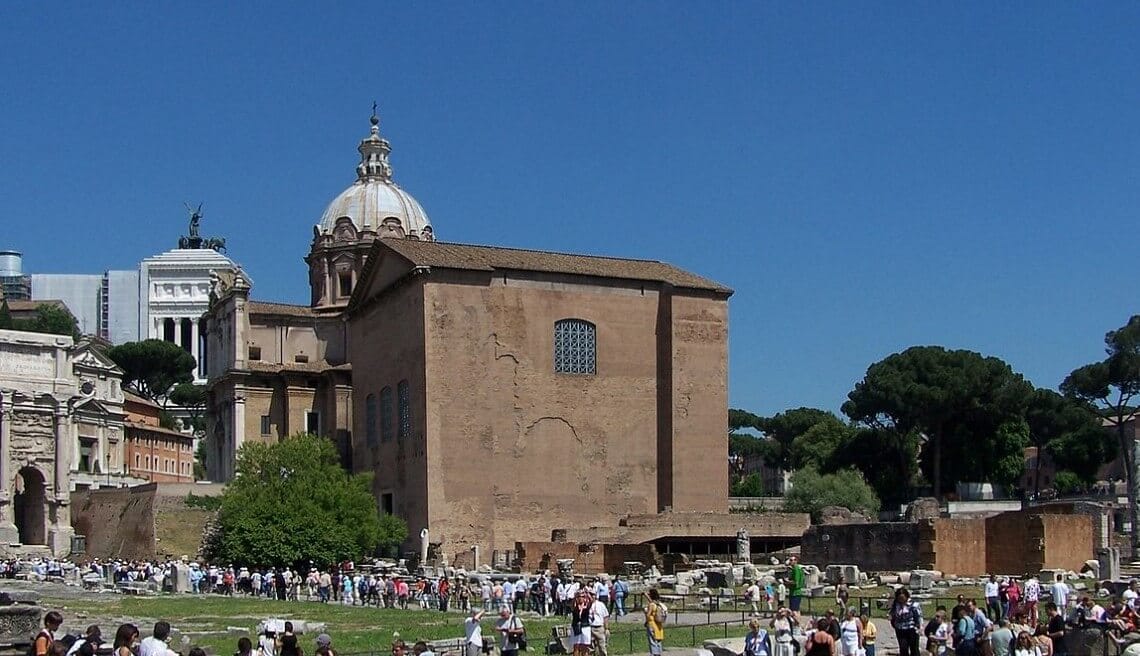
Today the senate stands proud amongst a wider open air museum of Roman ruins. Since it later formed part of a church, the former Rome Senate building has remained largely intact.
It can be visited as part of a trip to the Roman Forum as you walk along the Via Sacra. You cannot miss it as it is one of the only largely intact buildings.
The Restoration of the Rome Curia

Following the fire in 283 AD that gutted the Rome Senate house, Diocletian rebuilt the building to mirror the previous. Using the exact dimensions as last time, the building was painstakingly reconstructed.
The restoration put the building in good stead and it managed to survive to 630AD when it was incorporated into a church. Another restoration was undertaken in 1938 on the second millennial anniversary of Augustus by Mussolini.
The importance of the Rome senate building
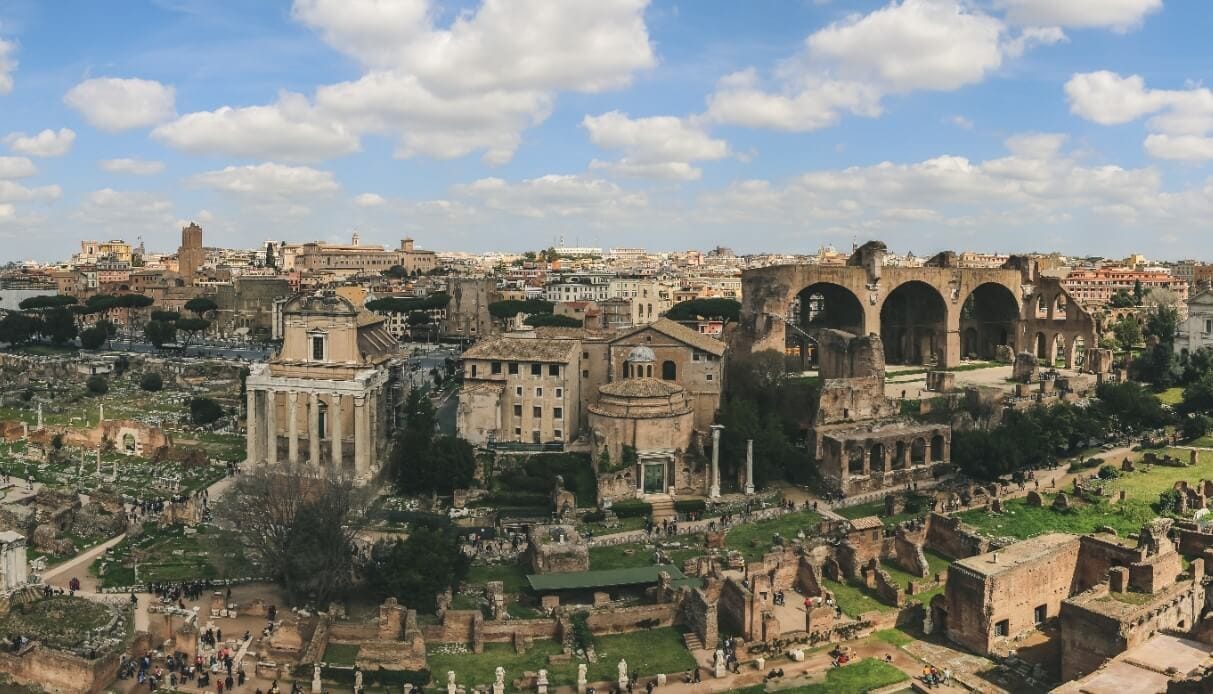
The Curia Julia, and other senate buildings, were of extreme importance. It was here that the emperors and senators would meet and discuss topics of the day.
It was the centre of the administration of the Roman Empire. Nowadays it serves as an important example of third century reconstruction over the original site.
Details about the Curia of the Roman Forum
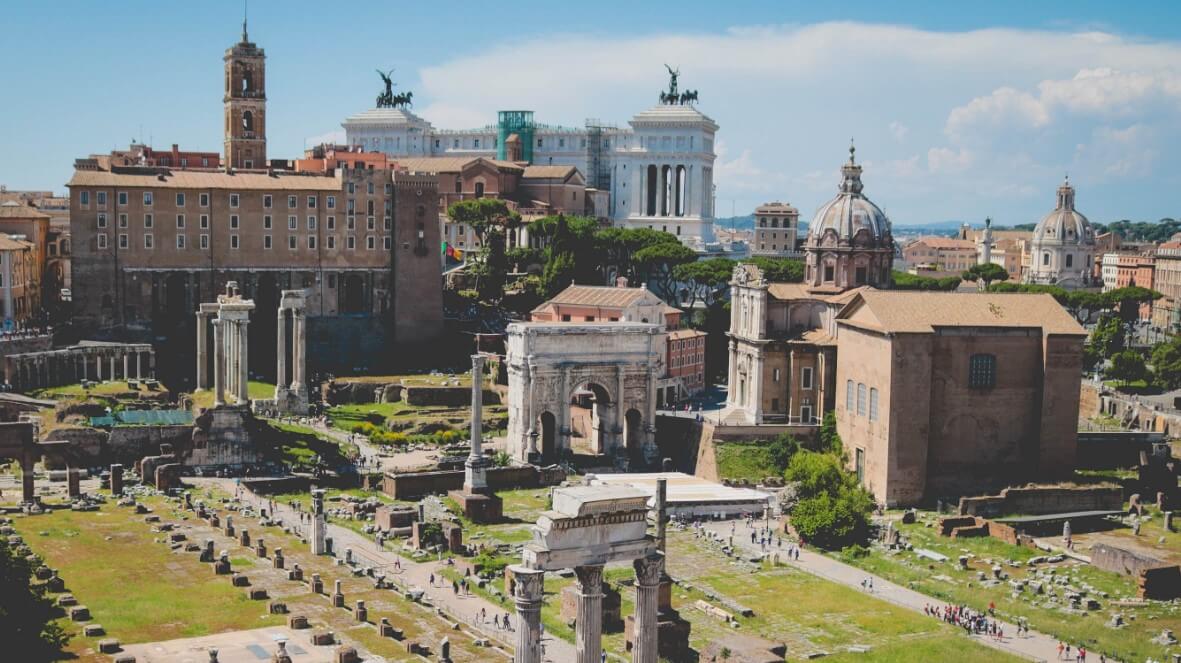
The construction is made of brick and marble and is accessed by stairs that lead to a pair of bronze doors. Actually, the doors themselves aren’t the originals – these were removed to the Basilica of St John the Lateran (and can still be seen there!) The Romans really did love to lift bits and pieces off other buildings and reuse them…
Inside it is estimated that the meeting house would have probably held about 300 officials comfortably – that was about half of the body of the Senate. The best feature on the inside is undoubtedly the colourful floor with its intricate patterns.
There are also 2 massive reliefs depicting scenes from the Trajan period. The ceiling is also a beautiful wooden structure that is often overlooked.
Short History of The Curia Julia Rome
A curia was a pretty steady staple of Roman life. The preceding curias had been constructed on an ancient temple. The Curia Julia was destroyed by fire damage in the 2nd century AD.
It was then reconstructed by Diocletian in subsequent years – you can still see the remnants of this renovation today in the Roman Forum Curia.
Hotels near to the ancient Roman Senate building
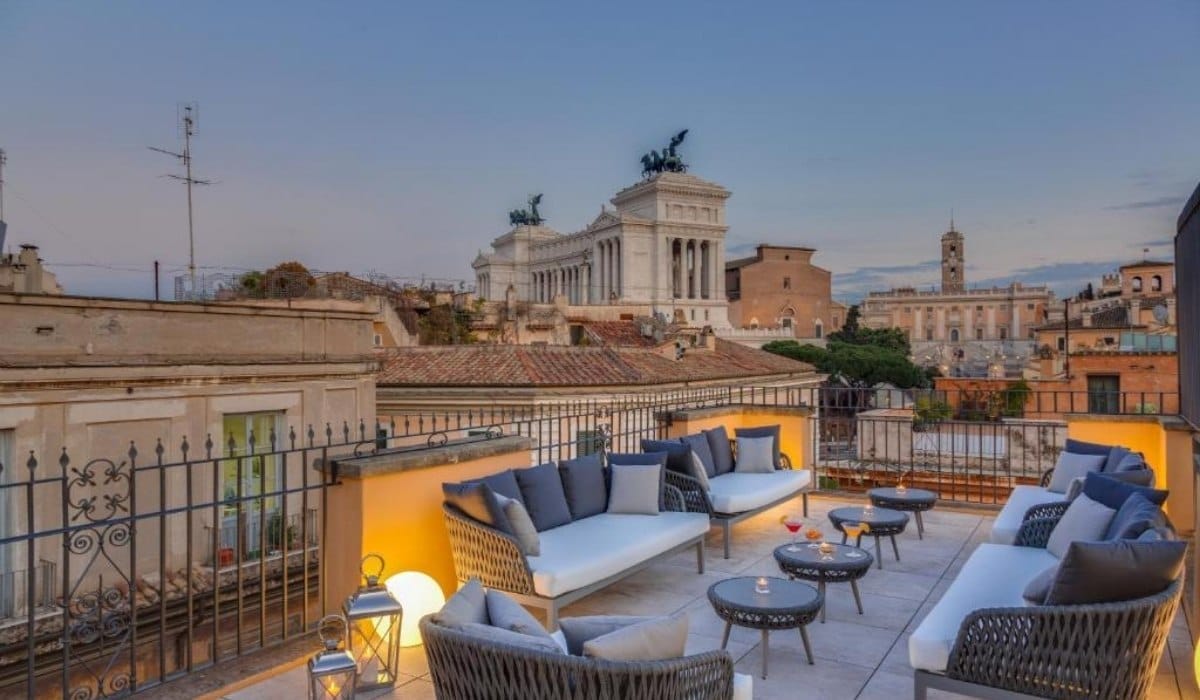
There are several hotels within a stone throw to the Curia Julia. Check them out below:
Otivm Hotel
Otivm Hotel might be hard to pronounce but it is not hard to see why it gets great reviews. The rooms are simple but modern and stylish, and the rood terrace boasts fabulous views. Breakfast is pretty good and is included in the price.
- Get a double room here in the off season starting at about €100.
NH Collection Rome
If you fancy a splurge near the Roman Forum this might be one to consider. The NH Collection Rome Fori Imperali boasts stunning interiors and simply breathtaking outdoor spaces.
To get one of the rooms with the delicious breakfast included will set you back at about €200 for a standard double.
Top Attractions near The Curia Julia in Rome

After exploring the Curia Julia, the heart of Rome’s ancient Senate, you’ll find yourself surrounded by some of the city’s most iconic landmarks.
Within a few steps, you can dive deeper into the stories, monuments, and views that define the Eternal City’s timeless charm.
- Roman Forum: Right beside the Curia Julia, the Roman Forum (get tickets here) is where history comes alive. Walk among temples, columns, and ancient streets that once buzzed with politics, trade, and public life. It’s an open-air museum waiting to be explored.
- Arch of Septimius Severus: Standing proudly nearby, this triumphal arch celebrates Roman victories with detailed carvings and grand proportions. It’s a must-see monument that captures the spirit and glory of imperial Rome.
- Temple of Antoninus and Faustina: Once dedicated to an emperor and his wife, this temple blends ancient Roman architecture with later Christian touches. Its towering columns and preserved façade tell stories that span centuries.
- Basilica of Maxentius and Constantine: This monumental ruin impresses with its scale and symmetry. Once one of ancient Rome’s largest buildings, it offers a stunning reminder of the city’s architectural ambition and power.
- Palatine Hill: A short climb from the Curia Julia, Palatine Hill offers sweeping views over the Forum and the Colosseum. Wander through imperial ruins and lush gardens while enjoying a peaceful break from the crowds below.
- Capitoline Hill: Just above the Forum, Capitoline Hill features elegant piazzas and museums filled with ancient art and artifacts. It’s the perfect place to admire the city from a historic vantage point.
- Temple of Saturn: Among the Forum’s oldest temples, the remaining columns of the Temple of Saturn are instantly recognizable. Pause here to imagine Rome’s earliest days and its devotion to the gods.
With these remarkable attractions so close to the Curia Julia, you can easily turn a single visit into a full day of discovery through the ancient heart of Rome.
Frequently asked questions

Here are some of our top received questions about this Rome Senate building.
What is the Curia Julia?
The Curia Julia is a former Roman senate located within the Roman Forum, Rome.
When was the Curia Julia built?
It is thought the construction was originally made in 29BC, and was damaged by fire in 283AD, and was therefore reconstructed after this.
Who built the Curia Julia?
It was commissioned by Julius Caesar in 44BC but finished by Augustus Caesar.
What does Curia Julia mean?
The Curia in this context was basically the word for the meeting place or “senate” of those people in officially designated political groups, or “curia”. The word Julia refers to Julius Caesar.
What was the Curia Julia used for?
As a meeting point, the building was used to discuss politics and other administrative matters.
Who restored the Curia Julia?
After the 283AD fire, the building was restored by Diocletian.
Conclusion
That’s the lowdown on the Curia Julia! If you are planning your trip to the Roman Forum and other ancient attractions in Rome, why not check out our guide to Roman Ruins.
Or, our section on the top things to do in Rome may also be of interest! And of course, you can also find plenty of tips and tricks on how to get skip the line tickets or city passes.
Fanny, an ardent admirer of ancient history and architecture, has been fascinated by the Colosseum since her first visit to Rome in 2012. As a key contributor to the Visit Colosseum Rome blog, she brings her passion for the Roman Empire’s monumental legacy to every article and guide.
